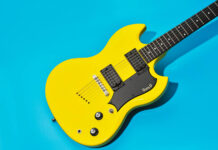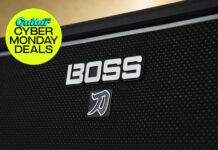
“You have to make a product where people don’t know that they need it yet”: John Woodland, guitar designer and Mastery Bridge founder
A modest, soft-spoken type whose achievements in the guitar world would justify plenty of immodesty, John Woodland does leap to his creation’s defence at one point in our conversation, when I mistakenly reverse the cause-and-effect that saw a simultaneous explosion in both offset-style guitars and Mastery Bridge products around the early 2010s, a trend that remains buoyant to this day.
Upon my suggestion that the boom in the Jazzmaster-inspired market must have really helped launch Mastery’s success, Woodland politely replies, “I really think Mastery Bridge was a large part of that.”
Of course it was. With the arrival of this exponentially more functional bridge in 2008 and its proliferation in the market soon after, along with the sturdier and more reliable vibrato that joined it, these groovy, stylish, but otherwise glitch-prone guitars suddenly became exponentially more viable for the gigging guitarist – and everybody started cranking them out as a result. But a lot went into forming Woodland’s design ethos long before the Mastery was even a glimmer in its creator’s eye.
Northern exposure
Woodland was born in Cambridge, Minnesota, in 1972, and although his parents weren’t particularly musical, the drive ran deep through the extended family. “When we would visit my grandparents’ home,” he says, “my uncle and cousins and relatives all played guitar and banjo, and my grandma played organ. It was just a given that you bring your guitar.”
Gifted his first guitar at the age of four, Woodland was taught to play by an uncle versed in traditional country music – “pre-Johnny Cash era. Carl Smith, Faron Young, Roy Acuff.” Self-declared a “pretty bad student,” Woodland wasn’t drawn to academic-based careers, and wasn’t sure he could actually make a living playing the instrument. But he had been indulging a curiosity for the thing since his early teens, taking guitars apart, putting them back together, and repairing and modifying them, and that seemed to indicate a pathway into his future.
“My father was an electrician,” he tells us. “We grew up out in the country and my dad wanted me to learn a trade… I was always into design and felt there could be more done with that. So I went to Red Wing Technical College to study musical instrument design and repair when I was 19. I was probably the worst student in the class, but I was the first to get hired.”
On weekends while he was still studying, and full-time after that, Woodland apprenticed under luthier Roger Benedict of East Bethel, Minnesota, who built guitars for Stevie Ray Vaughan, among others, before his untimely death in 1994.
“He and I would go cut down trees and make guitars from them,” Woodland recalls. “He had done so much fret work in his life that his arm was getting bad from it. He taught me a lot about fret work, about how what’s perfect to a carpenter isn’t perfect to a luthier, and what’s perfect to a luthier isn’t perfect to a jeweller. He taught me that you need to set a level of perfection for yourself that you think is acceptable.”
That level of precision would aid Woodland in a big way more than a decade later, but meanwhile there were guitars to repair, and designs to explore.
Toys in the attic
Parallel to his passion for guitar design, Woodland has long had a fascination with the unsung pioneers of the industry. His pursuit of knowledge in this arena has significantly informed his own work, while also leading to a few discoveries that are noteworthy by any measure.
“There are people in the industry who haven’t really been written about who are extremely important to the lineage of the guitar,” he says, “and one is John Deichman, who worked at C.F. Martin. He was factory foreman, and he drafted the OM and dreadnought guitars. I think it was 2004, shortly after Mike Longworth passed away – Mike wrote the history book on Martin Guitars in the late 60s and was the historian of the company for a very long time – and I went there to research a line of guitars made for the Oliver Ditson company in the 1910s, which turned out to be the dreadnought.
“I went in there and met with Dick Boak [director of the C.F. Martin Museum and Archives before his retirement in 2018], and Dick took me up to this part of the attic in the old North Street factory that had been locked for decades. We opened it up, and there were around 400,000 documents that hadn’t been read since the 1930s. There were just banker boxes full of correspondence and documents that, essentially, outlined the history of the modern American flat-top guitar as we know it. How it was designed, why it was designed, who designed it. There was so much information in there. I asked why Mike didn’t ever touch on this stuff, and the answer was, ‘Mike didn’t like to climb stairs.’”
In short, Woodland had hit the jackpot. During frequent visits to C.F. Martin in Nazareth, Pennsylvania, from his base in Minneapolis where he was working in repair for Willie’s Guitars, he plumbed the trove and laid out documents on big tables in the attic for a thorough perusal of the history of Martin guitar design in the early part of the 20th century.
“We started going through the old factory and the new factory and finding templates of all these guitars from the teens through the 30s,” Woodland recalls. “I found C.F. Martin’s personal wallet in a box in the wood room. There was stuff spread everywhere, and there was no archive room. Chris Martin had some family stuff and some ledger books in a couple safes.
“I remember showing Chris that I found all of Perry Bechtel’s correspondence regarding the Orchestra Model guitar, which is really what defined the flat-top: a 14-fret, solid headstock guitar with a pickguard and a belly bridge. And so, I found how and why this guitar was made in 1929. I remember looking at Chris and saying, ‘This is not only the history of your company, but the history of the American guitar, which defined music as we know it.’”
Form follows function
More than just a fascinating trawl through the origins of the modern American guitar, though, the exercise greatly informed Woodland’s own work – which, as it happens, has included designing six guitars for C.F. Martin, as well as for makers such as BiLT and others.
“One of the main take-aways I have from that, and you can say this about a lot of American manufacturing, it’s really shown me that brand image [in those days] was really based on the product itself. The old way of manufacturing is to make the best product you possibly can with the best materials, and let the product itself build your brand image. And I think the way that many companies approach it now is to start with an image, and have that image pyramid down to the products.
“One example was when Martin switched from bar fret wire to ‘T’ fret wire in 1934. They were contacting the Horton-Angel Company [a wire maker based in Massachusetts] and telling them to put a higher nickel content in the wire, because Martin used to roll bar fret wire at the factory for their guitars and they used a higher nickel content because it created a harder wire and it lasted longer. So, they’re corresponding with Horton-Angel and Horton-Angel is telling them, ‘Yeah, we can do it, we can change the alloy content, but it’s going to cost more.’
“And this was at the height of the Depression, you know? This is when C.F. Martin himself would use a pencil down to the eraser to save money, and Martin’s like, ‘We don’t care, this has to be the best possible wire you can make, and we’ll pay the added expense.’ And no one would have known otherwise. It’s nothing that they pitched, it was all about making the best possible product you could.
“That’s what’s going to sell your product; it’s not ads, it’s not T-shirts, it’s not fucking wine – all the things that companies do now. A lot of it was a perfect marriage of form and function. Traditionally, in the guitar industry, form has followed function, meaning that historically it was the purpose of the line that made it what it was, versus the art.”
Mastery of the craft
Having discovered the extent to which form followed function historically in guitar design, that principle came very much into play in Woodland’s creation of the Mastery Bridge. As revolutionary as that product has proven, and as much as it has been taken up by the industry, he didn’t see it so much as a product with a potential market, but simply as the correction of an existing design flaw.
“Mastery Bridge, for me, was like one repair,” he says. “I have tried to calculate how many guitars I’d worked on up to that point. I think it was like 15,000 guitars that I had repaired, so Mastery Bridge was a solution to a five-decade-old problem, and was just a single repair for me.”
Woodland designed the Mastery Bridge sitting at his workbench at Willie’s Guitars after puzzling out a way to improve this perennial weak link on the Jazzmaster. He and the team had made up a few examples of the original iteration – with its characteristic dual three-string saddles, four intonation screws, and mounting posts that fit into vintage Jazzmaster thimbles – and one was sitting on his bench when a certain Nels Cline walked into the shop in April of 2008.
“Jeff Tweedy has been my good friend since the mid-90s,” Woodland says, “but I didn’t really know Nels because he was fairly new to the band [Wilco] at that time. But I knew he played Jazzmasters and he was really nice, so Jeff introduced us and Nels and I kind of hung out, and I showed him the bridge.”
As Woodland tells us: “He said, ‘Yeah, sure, put it on my guitar!’ He was playing at the Dakota Jazz Club that night. So, I went through Nels’s guitar and installed it – he got the third Mastery Bridge ever made – and I remember going to the show that night and was kind of biting my fingernails. It was an early version, the string spacing was off, it was plain brass saddles, it was like a prototype and I had never put it in the hands of an onstage touring musician. But he really liked it, and at the end of the night he thanked me in front of the audience and commented on the product.”
What followed was much in line with any young designer’s dreams: Woodland made several for Cline, who spread the word to his friends Bill Frisell and the guys in Sonic Youth… who took 20 of them for the offsets they carted out on tour. Elvis Costello followed, and Tom Verlaine – “I met him in 2008 and gave him a bridge, and he loved it. It was a really proud moment for me” – and the more the Mastery Bridge became standard equipment for touring offset-guitar players, the more the hobby Jazzmaster and Jaguar players saw it as a must-have component. The more the Mastery was in use, the more viable these guitars became.
“I think Mastery Bridge really made those guitars usable for people who played live,” Woodland muses. “Because offset guitars didn’t explode after Nirvana. By making that more functional so that touring musicians could feel comfortable going out on stage without the product failing, I think the audience saw that and the guitars continued to grow in popularity, because Fender’s production of those guitars was next to nothing when we started.
“I remember a Fender rep being at Willie’s one day and I showed him a prototype. This was in 2008 and they had maybe two Jazzmaster models back then. And I remember the rep laughed at me and said, ‘We make 400 Jazzmasters a year. You’re going to do nothing with this!’”
Semi-circular reasoning
“As we all know, the Mastery Bridge, the subsequent vibrato, and a handful of Mastery products intended for use on other guitars – Telecasters, Rickenbackers, various hardtail models – have done booming business over the past decade. Not only have individual players gobbled them up as replacement parts, but respected makers such as Novo, Koll, Yanuziello, Nik Huber, Kauer, Collings, BiLT, Creston, Deimel, Harvester, Suhr, Scero and many others have employed them as original equipment. But the Mastery venture isn’t ending there; Woodland and the team have recently designed an entirely new pickup, the first run of which is just hitting the market. Like so much of Woodland’s work, however, these are not your drop-in replacements.
“They’re a completely different shape,” he tells us, “and we’ll sell a routing template for builders. Also the covers are made of Richlite, which is paper, essentially. They actually have a really unique sound. I’m working with a local winder, we’re doing everything here. I really want Mastery Bridge to be a very design-forward company. I don’t want to make Tele pickups and things that everyone else is making, because… I talk to people who do NAMM, and people in the industry all say, ‘Oh, how was NAMM?’ and it’s the same regurgitated crap that’s always there.”
In addition to hitting the open market around the time of writing, the Mastery pickup – a modernistic, semi-circular design – has already appeared on the Nothing Guitar, designed by Woodland and manufactured by BiLT, and so far played by both Nils Cline and Bill Frisell.
Woodland concludes: “I’m trying to make products for independent luthiers so that they can do better and make more unique things that are offered than with other large guitar manufacturers. You have to make a product where people don’t know that they need it yet, and as soon as they see it they realise they do. And the approach with the pickups was like it was in the 1920s and no one had ever done this before. How would the shapes look? Take a totally different approach to the line, just to try to do something that might organically come off different.”
Visit masterybridge.com for more information.
The post “You have to make a product where people don’t know that they need it yet”: John Woodland, guitar designer and Mastery Bridge founder appeared first on Guitar.com | All Things Guitar.
Source: www.guitar-bass.net












